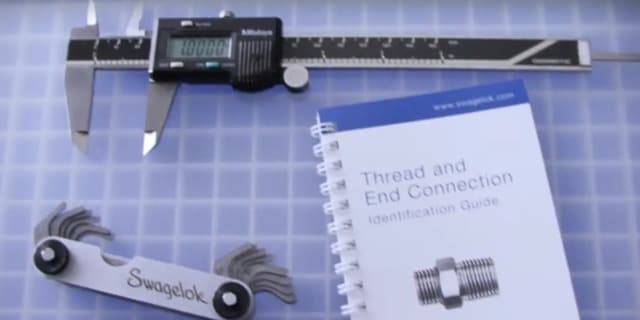Calipers, Combs, And Guides Help Make Sense of Threads

Can you tell the thread size and thread pitch on a component just by looking at it? Neither can we. That's why we have tools that eliminate the guesswork.
The A to Z of Pitch and Thread
When you look at a thread, you'll see peaks (called crests) and valleys (called roots). We call the part between the crest and the root the flank. The first thing you want to find out is whether the crests are all the same diameter. That would mean you have straight threads. We use our calipers to measure the first, fourth and last crests. If the measurements are the same, you have straight threads. If you get three different measurements, you have tapered threads.
There's another way to tell whether you have tapered or straight threads if you are working with Swagelok parts. Other than standard NPT, Swagelok fittings are uniquely marked to show ISO tapered or ISO parallel threads.
It surprises some people that straight threads are not designed to seal on their own. They need a gasket, O-ring or metal-to-metal contact to finish the job.
When the mating threads come together, tapered threads seal. Sealant is also necessary to prevent leaks. We usually use PTFE tape or a product such as SWAK.
Consider the Pitch
Pitch is how close together the crests are in your thread. Pitch is usually expressed as the number of threads per inch.
Straight threads come in three standard kinds of measurements:
- SAE (Society of Automotive Engineers)
- ISO 228/1 (also known as British Standard Pipe Parallel)
- Metric
Tapered threads also have three standard forms of measurement:
- NPT (National Pipe Thread)
- ISO 7/1 (also known as British Standard Pipe)
- Metric
Flanks can come in different angles:
- Whitworth
- Unified
- Metric
To discover the pitch, we use a thread comb, also known as a pitch gauge. It looks a bit like a pocketknife, but the blades have saw-tooth edges that fit into the thread roots. We try different blades until we find an exact match. Some fractional and metric thread forms are very similar, so we take the time to make sure it's a true fit.
Threads on two parts must have the same size and type of threads if you want to connect them. But you don't have to guess. Check in with Swagelok Northwest (US) and we'll work with you to get the right answer. We have a board on-site with different thread sizes. If you come in with a part, we can see which sample fits.
Swagelok has also created a handy guide for this information, you can download it online. The guide includes terminology, thread ID reference tables, and step-by-step instructions for identifying threads.
